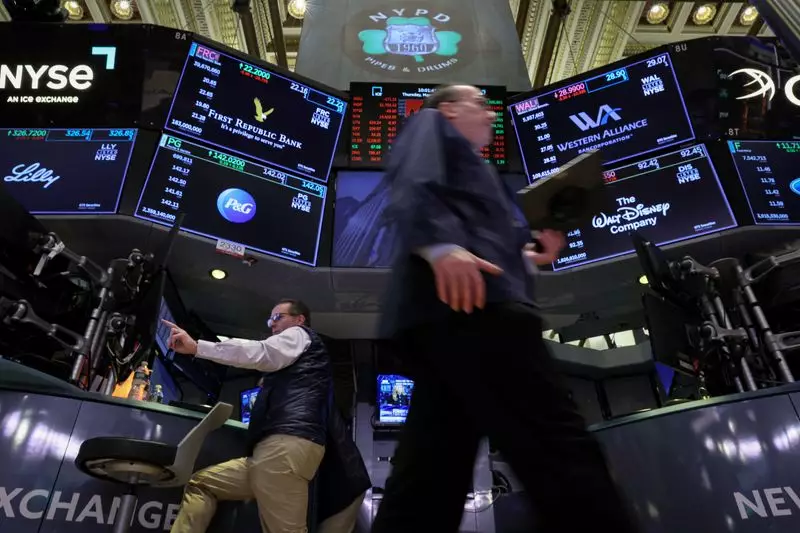US stock futures are experiencing a downturn as traders reassess the financial landscape following a surprisingly strong jobs report from the previous week. The implications of this employment data are significant, as they have reignited discussions about the Federal Reserve’s monetary policy and the trajectory of interest rates for the upcoming year. As of the latest readings, futures for major indices—the Dow Jones, S&P 500, and Nasdaq 100—are all reflecting bearish sentiments, with decreases of 0.3%, 0.5%, and 0.8% respectively. This modest retreat follows an upbeat employment report that saw the addition of 256,000 jobs in December, compelling market participants to reconsider expectations around forthcoming interest rate cuts.
The conundrum is palpable: with the unemployment rate dipping to 4.1% from 4.2%, the Federal Reserve is now faced with heightened inflationary pressures which could deter aggressive rate reductions. Market analysts are concerned that the combination of robust job growth and a tightening labor market might prolong the cycle of elevated interest rates, consequently affecting stock valuations and investor sentiment moving forward.
Compounding the uncertainty is the anticipation surrounding upcoming inflation data, scheduled for release later this week. The consumer price index (CPI) for December is projected to show a year-over-year increase of 2.9%, a notable uptick from November’s reported growth of 2.7%. This inflation metric is widely regarded as a key barometer for economic health and is expected to dominate investor focus. The Fed has cautiously approached further rate cuts, and this imminent CPI reading will be pivotal in shaping policymakers’ outlook on inflation and interest rates.
Interestingly, despite optimistic forecasts from some Fed officials suggesting that inflation could be easing, the actual data presents a more complex picture. The prevailing view suggests that while inflation has remained elevated, the broader economy is not showing signs of overheating. Such mixed signals create an environment marked by uncertainty, impacting how traders position their portfolios in an economically sensitive stock market.
The Earnings Season: Key Players to Watch
As the earnings season commences, expectations are building around the quarterly reports from major Wall Street banks, including JPMorgan, Citigroup, and Goldman Sachs, which will all be unveiling their results this week. Stakeholders are particularly interested in how these financial institutions respond to fluctuating interest rates and the evolving regulatory landscape under President-elect Trump’s anticipated policies.
The banking sector’s earnings are forecasted to climb nearly 10% year-over-year, according to industry data from LSEG IBES. However, the stability of net interest income, a crucial performance metric, becomes increasingly uncertain given the pressures from economic conditions and Federal Reserve policies. Investors will be closely monitoring how these banks navigate the potential pitfalls of compressed margins while capitalizing on robust deal flows anticipated to emerge from a business-friendly environment.
China’s Expanding Trade Surplus
Globally, the dynamics of international trade are also shifting, particularly in China, where the trade balance exceeded expectations and rose to $104.84 billion in December. This growth is attributed to a pre-emptive strategy by Chinese exporters in anticipation of possible tightening from President-elect Trump’s administration regarding tariffs. The surge in exports, clocking in at a 10.7% year-on-year increase, exceeded analyst predictions of 7.3%, suggesting that local firms are proactively adjusting their operations in response to anticipated global trade changes.
Interestingly, while exports surged, imports showed more muted growth at 1% for December, indicating a mixed picture for domestic demand despite ongoing stimulus efforts from Beijing. This trade surplus not only strengthens China’s economic position but also poses questions about future US-China relations, especially regarding trade policies under new leadership in the United States.
In the commodities market, oil prices showed signs of resilience, buoyed by the announcement of additional sanctions on Russian oil producers, which have implications for global supply chains. The price of West Texas Intermediate (WTI) crude climbed to $77.04 a barrel, while Brent crude reached $81.20. The continued upward trend in crude prices, having risen over 6% since mid-last week, signals growing market concerns over potential supply disruptions, particularly as China and India, leading global oil importers, may need to seek alternative sources.
These developments reveal a multifaceted economic landscape where stock markets, consumer price indicators, corporate earnings, international trade balances, and commodity prices are intricately linked. As investors navigate this period of uncertainty, staying informed about these various influences will be crucial in making informed decisions in an evolving marketplace.

